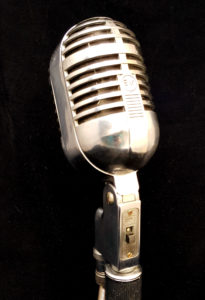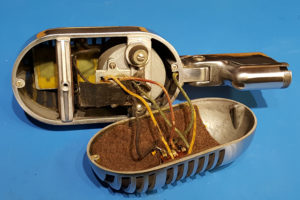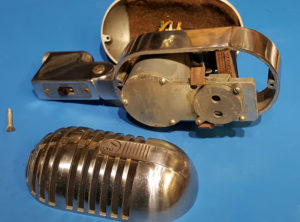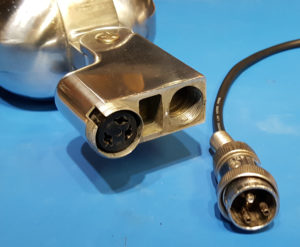
Electro-Voice 726 Cardyne 1 Microphone
I’ve had this Electro-Voice mike in my collection for a number of years, but never bothered to test it since it had an Amphenol MC-3 connector on it and I didn’t have the proper cable. But, I acquired a box of Amphenol connectors recently, so I thought it was time to check out this classic mike.
This is a large microphone, comparable in size to my Shure 556 “fat-boy, Elvis” microphone. It weighs in at about 2 ½ pounds. The best I can tell, it first appeared on the market in the late 1940s.
According to the EV spec sheet:
The CARDYNE microphones are cardioid unidirectional dynamic types operating on the E-V Mechanophase principle. They utilize dual phase shifting diaphragms to produce a high degree of uni-directivity at all frequencies.
The CARDYNE models are designed for extremely accurate reproduction of music and speech. The directivity gives it unusual versatility in increasing the working distance from the user by reducing reverberation and acoustic feedback. High output provides an excellent signal-to-noise ratio for broadcasting studio pick-up.
My unit is in excellent physical condition externally, but I decided to open up the mike to make sure the insides were OK before wiring up the new cable. Two screws on the back loosened the rear of the case and two screws under that loosened the front cover.

Electro-Voice 726 Cardyne 1 Microphone, internal back view.
The insides were clean and not corroded, but all of the rubber shock-mount material had hardened and some of it turned to powder. Since the cartridge assembly just flopping around inside the case, I needed to replace all of the shock-mount material.
This microphone achieves its cardioid directionality by means of a resonance chamber that is part of the dynamic cartridge assembly. This assembly rests against a block of sponge rubber that is about ½ in. thick, 1 inch high, and two inches long. I was easily able to cut a replacement piece from a piece of ½ rubber that I had and glued it into place. There were a couple of bumpers on the front of the cartridge assembly that rested against the front of the case. These I replaced with pieces of self-adhesive rubber that I cut from a sheet that I bought from a craft store.
The shock mounts that held the back of the resonator to the mike frame were not as simple. What I needed were eight ½ inch diameter rubber washers, ¼ inch thick, with a ¼ inch hole in the center. I used a hole punch to punch the ½ circles out of a sheet of rubber, and then punched a ¼ inch hole in each one of those. These were close enough in size that I was able to re-assemble the shock mounts with the new rubber pieces, tighten the screws, and verify that is worked properly.

Electro-Voice 726 Cardyne 1 Microphone, internal front view.
I double-checked the wiring inside of the mike to make sure that I hadn’t broken any wires, and then put the mike back together. I didn’t have any silk or thin foam to replace the windscreen inside the shell, but it was in fairly good shape, so I’ll save that for a later date. I then used my Dremel tool with a brass brush to remove oxidation from the exterior of the mike, and it cleaned up nicely.
I wired up a new cable for the mike to go from the Amphenol connector on the mike to a standard male XLR connector. I set the impedance switch on the back of the mike to “Low” and plugged the mike in. It worked.

Amphenol MS-3 connectors.
Then, into the studio for some comparative recordings between this E-V mike and the Shure 556. The E-V is brighter and has a higher output than the Shure. Both mikes seem to have a significant amount of distortion. I am guessing that the capsules in both mikes are showing their age and may have some damage. Replacement capsules of the same type are not available. I could upgrade to a newer capsule, but then they would no longer be vintage mikes.
So, I’ll just be on the lookout for NOS capsules on eBay. There was a NOS capsule for a Shure 55S on eBay this week, but the mounting is entirely different that the 556, so I passed on it even though it is probably the same capsule. These mikes will be mostly for decoration, except for that occasional funky recording project that pops up now and then.
What is interesting is the amount of mechanical apparatus that was needed back in the 40s to create a directional mike. My new Electro-Voice N/D 468 microphones provide hyper-cardioid directionality and great sound in a package that has probably 1/8 the size of the old 726. We’ve come a long way in the past 70 years!

